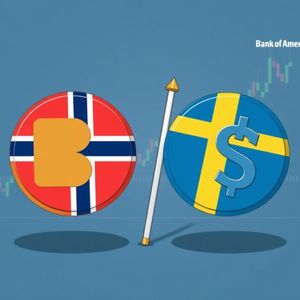BitcoinWorld NOK SEK Forecast: Alarming Drop Predicted by Bank of America In the dynamic world of financial markets, where volatility is the only constant, understanding the intricate dance of currency pairs is crucial. Even for those deeply immersed in the realm of cryptocurrencies, the ripple effects of traditional forex movements can be significant. Recently, a major forecast from Bank of America regarding the NOK SEK forecast has sent ripples across the foreign exchange landscape, signaling a potentially significant shift for the Nordic currencies. If you’ve been watching the markets, or simply curious about how global economic shifts impact even the most stable currencies, this detailed analysis will provide clarity on why one of the world’s leading financial institutions is predicting a notable decline for the Norwegian Krone against the Swedish Krona. What’s Driving the Alarming NOK SEK Forecast from Bank of America? Bank of America (BofA) has issued a striking prediction, anticipating the NOK SEK forecast to tumble to 0.90. This isn’t just a minor fluctuation; it represents a significant bearish outlook for the Norwegian Krone relative to its Swedish counterpart. But what exactly is fueling this strong conviction from a financial giant like BofA? The core of their argument lies in a combination of macro-economic divergences and differing policy trajectories between Norway and Sweden. While both are Nordic economies, their responses to global challenges and their domestic fundamentals are creating a noticeable gap. BofA’s analysts point to several key factors contributing to this anticipated decline: Monetary Policy Divergence: The differing stances of Norges Bank (Norway’s central bank) and the Riksbank (Sweden’s central bank) play a pivotal role. Commodity Price Sensitivity: Norway’s economy is heavily influenced by oil and gas prices, making the NOK susceptible to shifts in global energy markets. Domestic Economic Resilience: Varying levels of resilience in their respective housing markets, inflation trends, and consumer spending habits are creating a wedge. Global Risk Appetite: In times of global uncertainty, investors often seek perceived safe havens, and the relative appeal of NOK versus SEK can shift dramatically. This forecast suggests that the prevailing bearish trend is not just a temporary blip but a sustained movement driven by fundamental economic realities. Unpacking the Norwegian Krone Outlook: Why the Weakness? The Norwegian Krone outlook , according to Bank of America, appears increasingly challenged. Despite Norway’s robust sovereign wealth fund and its status as a major oil producer, several factors are weighing down its currency. One primary concern is the sensitivity of the NOK to global oil prices. While higher oil prices generally benefit the Krone, a sustained period of lower demand or increased supply could quickly erode its strength. Furthermore, Norges Bank’s monetary policy has been a subject of scrutiny. While they have been proactive in addressing inflation, the market’s perception of their future rate path, especially in comparison to other central banks, can influence currency valuation. Consider these points regarding the Norwegian economy and its currency: Oil Price Volatility: A significant portion of Norway’s exports and government revenue comes from oil and gas. Any sustained decline in crude prices directly impacts the nation’s economic health and, consequently, the NOK. Inflation Dynamics: While Norges Bank has been battling inflation, if price pressures ease faster than expected, it might reduce the urgency for further rate hikes, making the NOK less attractive for carry trades. Global Economic Slowdown: As a small, open economy, Norway is susceptible to global economic downturns, which can reduce demand for its exports and dampen investor sentiment towards its assets. Labour Market Trends: Weakening employment figures or a softening in wage growth could signal broader economic deceleration, putting downward pressure on the Krone. The cumulative effect of these factors contributes to BofA’s cautious stance on the Norwegian Krone. Analyzing Swedish Krona Depreciation: Is it a One-Way Street? While the forecast highlights NOK weakness, it implicitly suggests a relative strengthening of the SEK, or at least a lesser degree of depreciation. The journey of the Swedish Krona depreciation has been a long and winding one, with the currency often underperforming its peers for various reasons. However, Bank of America’s forecast implies that the SEK might be finding some footing, or at least facing fewer immediate headwinds compared to the NOK. Sweden’s economy faces its own set of challenges, particularly its highly leveraged housing market and the Riksbank’s often dovish stance. Yet, there are elements that might be providing some support: Riksbank’s Policy Shift: After a period of aggressive rate hikes to combat inflation, the Riksbank might be perceived as closer to the end of its tightening cycle, or even signaling potential cuts sooner than Norges Bank, which could paradoxically reduce some of the long-standing bearish pressure on the SEK. Export-Oriented Economy: Sweden’s strong export sector, particularly in manufacturing and technology, could provide a buffer, especially if global trade conditions improve or remain stable. Relative Valuation: After years of depreciation, some analysts might see the SEK as undervalued, presenting a potential floor for further declines against certain currencies. Inflationary Pressures: While inflation has been high, signs of it peaking or beginning to decline could lead to a more stable outlook for the Krona. The narrative around the SEK is complex, but BofA’s forecast suggests that its relative position against the NOK is set to improve, even if the Krona itself isn’t set for a massive rally against other major currencies. Bank of America Currency Insights: A Deeper Dive into Their Rationale Understanding the specifics of Bank of America currency analysis provides valuable insight into their conviction. Their forecasts are typically built upon a sophisticated framework that integrates quantitative models with qualitative assessments of global economic and political landscapes. For the NOK/SEK pair, their rationale likely hinges on a meticulous comparison of economic fundamentals and policy expectations. BofA’s methodology often involves: Interest Rate Differentials: Projecting future interest rate paths for Norges Bank and the Riksbank to determine which currency offers a more attractive yield. Terms of Trade Analysis: Assessing the impact of commodity price movements (especially oil for Norway) on each nation’s balance of payments. Growth Differentials: Comparing GDP growth forecasts, labor market strength, and consumer spending patterns to gauge economic momentum. Risk Premium: Evaluating the market’s perception of risk associated with each economy, which can influence capital flows. Technical Analysis: While fundamentals drive long-term views, technical indicators often confirm or precede major shifts, providing additional conviction. Their projection to 0.90 suggests they see a significant and sustained divergence in these fundamental drivers, making the NOK relatively less appealing than the SEK over the forecast horizon. This is not merely a short-term trade recommendation but a strategic view based on deep economic analysis. Navigating Forex Market Trends: What This Means for Traders For currency traders and investors, understanding these evolving forex market trends is paramount. Bank of America’s bold forecast for NOK/SEK presents both challenges and potential opportunities. If BofA’s prediction holds true, it implies that going ‘long SEK/short NOK’ could be a profitable strategy. However, navigating such a trade requires careful consideration of risk management and market volatility. Here are some actionable insights for traders: Monitor Economic Data: Keep a close eye on inflation reports, GDP figures, employment data, and central bank statements from both Norway and Sweden. Unexpected shifts can alter the forecast. Watch Commodity Prices: Given Norway’s oil dependence, fluctuations in crude oil prices (Brent particularly) should be a key watch factor. Consider Interest Rate Expectations: Any changes in market expectations for Norges Bank or Riksbank interest rate decisions will directly impact the pair. Risk Management: Utilize stop-loss orders to limit potential losses and define clear profit targets. The 0.90 level serves as a strong target, but markets can overshoot or undershoot. Diversification: For those with broader portfolios, understanding these cross-currency dynamics can inform hedging strategies or diversification efforts, even if you’re primarily focused on other asset classes like cryptocurrencies. While Bank of America’s forecast provides a strong directional bias, market dynamics are always subject to change. Prudent traders will combine this institutional insight with their own analysis and a robust risk management framework. Challenges and Opportunities in the NOK/SEK Dynamics Every significant market forecast comes with its own set of challenges and opportunities. The predicted fall of NOK/SEK to 0.90 is no exception. Challenges: Unforeseen Global Events: Geopolitical tensions, sudden shifts in global commodity demand, or unexpected economic data from major trading partners (like the Eurozone or China) could disrupt the predicted trend. Central Bank Surprises: While BofA bases its forecast on current and expected policy, central banks can surprise the market with unconventional measures or sudden shifts in their rhetoric. Liquidity Risks: While NOK and SEK are liquid currencies, extreme volatility could lead to wider spreads and higher trading costs, especially during unexpected news events. Confirmation Bias: Traders might be tempted to blindly follow the forecast without doing their own due diligence, leading to potential losses if the prediction doesn’t materialize. Opportunities: Directional Trading: The most direct opportunity is to initiate trades that capitalize on the anticipated NOK weakness relative to SEK, such as shorting NOK/SEK. Hedging Strategies: Businesses or investors with exposure to Norwegian assets or revenues could consider hedging their currency risk by taking positions that benefit from a weaker NOK. Portfolio Rebalancing: For long-term investors, this forecast might prompt a review of their exposure to Nordic assets, potentially rebalancing towards Swedish assets or away from Norwegian ones. Enhanced Market Understanding: Even if not directly trading the pair, understanding the drivers behind this forecast deepens one’s comprehension of interconnected global economies and currency dynamics, which is invaluable for any market participant. The key is to approach this forecast not as a certainty, but as a highly probable scenario based on expert analysis, requiring continuous monitoring and adaptive strategies. Bank of America’s compelling forecast for the NOK SEK forecast to reach 0.90 underscores the significant divergences emerging between the Norwegian and Swedish economies. Driven by differing monetary policy paths, commodity price sensitivities, and domestic economic resilience, the bearish trend for the Norwegian Krone against the Swedish Krona appears set to continue. This analysis highlights the intricate factors that shape currency valuations and the profound impact of institutional insights on market sentiment. For traders and investors, staying abreast of these developments and understanding the underlying economic rationale is crucial for navigating the ever-evolving forex landscape. Whether you’re a seasoned forex trader or simply interested in global economic shifts, the unfolding story of the NOK/SEK pair offers a fascinating case study in currency dynamics. To learn more about the latest Forex market trends, explore our article on key developments shaping currency valuations and institutional adoption. This post NOK SEK Forecast: Alarming Drop Predicted by Bank of America first appeared on BitcoinWorld and is written by Editorial Team











